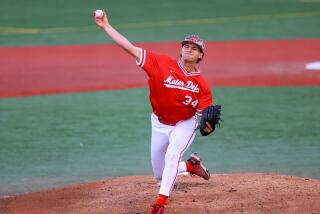THE COLLEGES / Mike Hiserman : CSUN Foes Say Sharts’ Power Lacks Dimension
- Share via
There have been 13 Sharts shots, nary a one short. So there is reason to believe that Scott Sharts would be the California Collegiate Athletic Assn. home run leader even if Cal State Northridge’s ballpark were the size of a runway at LAX.
But Matador Field does not approach such gargantuan dimensions.
It is 325 feet down the lines, 375 feet to the power alleys and 400 feet to center and seems even cozier when the prevailing wind is blowing.
Because of this, there are some who would seek to put an asterisk beside each home run Sharts sends into orbit. In February, after CSUN blasted five homers--including three by Sharts--in a game, several Cal State Dominguez Hills players grumbled that a couple were merely fly balls that blew out.
Northridge, which has a proud baseball history, has had power hitters before. A couple, as does Sharts, played first base.
One, Jason Thompson, enjoyed a long major league career with the Tigers, Angels and Pirates, but he never hit more than 10 homers in a season for CSUN.
John Balfanz, drafted by the Cardinals in 1988, was another. He hit a school-record 42 in his three-year career, but his best season was 1987 when he had 19.
At his current pace Sharts, a 6-foot-6 sophomore, would match that total with more than a dozen games left.
Bill Kernen, who is in only his second season as coach of the Matadors, doesn’t have much of a basis for comparing Sharts to bygone Matador sluggers.
But Bob Hiegert does.
Hiegert, CSUN’s athletic director, was baseball coach at the school from 1967-84 and guided the Matadors to a pair of wins in the NCAA Division II World Series.
The top slugger in Hiegert’s era was Rondal Rollin, who as a sophomore in 1980 batted .418 and led the nation in home runs (24), hits (105) and runs batted in (72).
“For me, the person Sharts parallels most with is Rollin,” Hiegert said while witnessing a three-homer performance by Sharts against U.S. International last week. “In terms of pure physical strength, he was a game-breaker. It didn’t matter who was pitching. It didn’t matter what park it was or who was batting in front or behind him. If he hit the ball hard, it was gone.”
Hiegert also labeled Thompson and Hank Clark (CSUN ‘81, Astros) as legitimate power hitters. Balfanz, Hiegert said, benefited most from the friendly confines of Matador Field.
But of Sharts, Hiegert says, “Scott’s home runs are legit. I haven’t seen one that hasn’t been hit hard.”
Add slugfest: Sharts hit a Southern Section-record 32 home runs in his career at Simi Valley High, but he came to Northridge via Miami, where he spent most of last season as a relief pitcher.
After seeing only limited action for the Hurricanes, he asked to be released from his scholarship after last season.
“I knew it would be tough, but I thought I would have more of a chance to play,” Sharts said of his tenure at Miami. “(But) it didn’t really affect me until they actually took the bat out of my hands and I just became a pitcher. That’s what really bothered me.”
Seduced by the prestige of Miami’s perennially ranked program out of high school, Sharts stuck to the basics when making a selection the second time.
“I wasn’t looking for the offer,” he said. “I didn’t even really care about what type of program it was. It didn’t have to be Division I. I just wanted a place to play, it was as simple as that.”
He found it at Northridge, which needed pitching help and did not have a returning first baseman. That he was joining an extremely young team caught in a transition from Division II to the major-college level was a positive rather than a negative.
“That’s one of the things I was looking forward to,” said Sharts, who before Friday night’s game at Pacific was batting .360 and leading CSUN in homers, runs batted in (29) and total bases (79). “I knew I was coming into a program of all freshmen and sophomores, but I figure if we play together for a full year, by the time we go Division I next season it’s going to pay off. We’re going to be tough.”
Northridge (14-12) has played inconsistently thus far, but Sharts is still encouraged.
“We have a lot of good talent on this team,” Sharts said. “I don’t think some of our guys know how good we can be. But this is what I expected--a bunch of young guys trying to adjust to the college level.
“It’s a tough step. I know. I felt it last year.”
Making tracks: Several area athletes known for their football skills are tackling track and field with equal elan.
Freddie Bradley, Moorpark College’s All-American running back, ranks fourth in the Western State Conference in the 100 meters with a best of 10.79 seconds. Lamark Allen, a Valley College defensive back, is fifth in the long jump with a leap of 22 feet 7 inches.
David Nottoli, who played wide receiver for Glendale College, is tied for fourth in the 200 at 22.1, and Ryan Raposa, a Ventura College running back, has the fourth-best javelin throw, 177-7 1/2.
More to Read
Go beyond the scoreboard
Get the latest on L.A.'s teams in the daily Sports Report newsletter.
You may occasionally receive promotional content from the Los Angeles Times.











